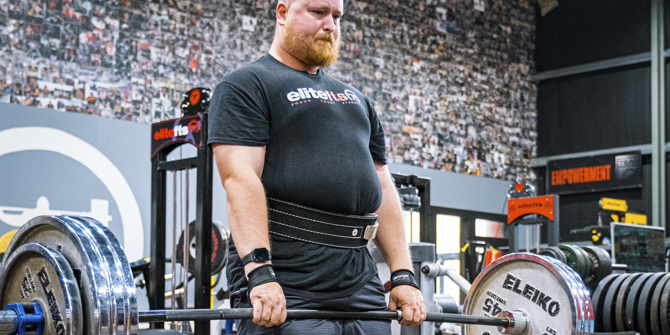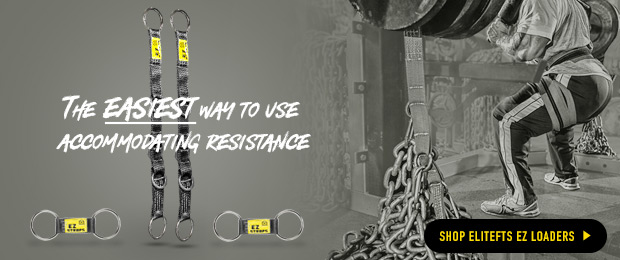
Read closely. I'm going to share with you one of the biggest things I've employed in my over ten years of coaching powerlifting. It’s the same thing that produced countless podium finishers at a half dozen IPL World Championships, not to mention National Championships and North American Championships.
And guess what? It doesn't have anything to do with lifting weights. It deals with how you put it down.
In my tiny Santa Cruz Strength Gym in Santa Cruz, California, we routinely turned out drug-free powerlifters who could barbell deadlift 2.5 to 3 times their bodyweight thanks to this. But how?
The Nervous System
I've always had a "nervous system first" approach to strength training. Strength is the neurological skill of recruiting muscle fibers to move a load, so why not improve the strength of the nervous system by making slight modifications to an exercise as you're already doing?
Jennifer Thompson, a billion-time world champion herself, knows the value of a strong nervous system; that’s why she uses heavy support holds on the bench press over 500 pounds. Her ability to manage that kind of weight, or more at arm's length, primes her nervous system to bring 300 pounds to her chest and press it back out.
It's the same reason we walk out a squat with 110% of our max on it before a meet or perform rack pulls in the deadlift: to expose the nervous system to a higher load. But again, this is not about lifting; this is about putting it down.
What Does The Science Say?
First, let’s touch on the science stuff. Russian sports scientists in the 70s and 80s determined that most Average Joe's walk around only being able to access 30 to 40% of their existing muscle fibers. That includes beginner lifters, too. The rest of an individual’s potential is reserved for emergencies. That is why most researchers and lifters believe that the considerable gains in a beginner lifter’s strength career can be attributed to neurological adaptations.
Even the most elite athletes can only tap into up to 70% of the muscle fibers in the body during competition.
Knowing that we are fighting an evolutionary battle against the nervous system, which is built for preservation and not performance, we have to find ways to leverage maximal recruitment with each rep in the time that we have in the gym before a meet. That's why I am such a staunch advocate for intentionally setting the deadlift down after each rep. I will give you three reasons why this is better than simply staying attached to the bar and crashing into the ground, making a sound akin to a Prius in a garbage disposal.
1. Use All Of Your Available Tissue
Remember, most beginner lifters can only recruit about 40% of their muscle fibers overall. Only the highest-trained athletes in the world can recruit more through consistent training. However, eccentrics can drastically increase motor unit recruitment (1). This means if you do eccentrics, you can use more of the available muscle and contractile tissue in things like your hip extensors (e.g., hamstrings) during deadlifts.
Plus, a boatload of recent research shows that eccentrics can encourage greater muscle hypertrophy, greater neural activity, and larger force production compared to both isometric and concentric muscle contractions (2).
Even if you don't read any of the reasons after this one, this one is pretty damn compelling. Lowering your deadlift with control will almost always give you more bang for your training buck.
2. Eccentrics Are Teachers
Throughout my career, I’ve only ever coached the down or eccentric portion of the lift. Maybe you do, too. Think about the bar path on the way down in the squat. If you’re looking at a lifter from the side, the end cap of the bar should track in a straight line over the center of the foot.
As a coach, my job is to give the lifter cues that facilitate that. Sometimes, we need to change bar placement, foot stance, or add shoes with an elevated heel to improve ankle range of motion. We’re wasting our time coaching the concentric portion of the lift for the most part. It’s just UP. The lifter will figure out how to generate the intensity needed to get out of the hole without much input from you.
But what about deadlifts? We really only talk about the setup in a deadlift. Keep it close to the shins, drop your hips, engage your lats, etc. Whether conventional or sumo, we know that if the bar is closer to the body, you have better leverage. These technique corrections can be made at lighter weights for the UP portion of the lift, but to truly improve the neurological skill of strength, you should be coaching them at heavier weights on the way DOWN.
RECENT: Use the Skater Squat as a Deadlift Alternative
A slow eccentric in the deadlift teaches the lifter to brace and hinge properly to keep the bar close to the legs. Simply mastering that will ensure your longevity at a high level. As the bar passes below the knees, that back angle we’ve hinged into stays mostly the same, and all we do from there is push the knees forward to lower the bar to the ground. You'll often end up in a perfect starting position once the bar is on the ground.
This ending position is the most optimal starting position for the next rep. And the most optimal for the heaviest single.
Teach the down to improve the up.
3. You’re Messing Up The Vibe, Man
Remember how I said our nervous system is built for preservation, not performance? Think about how your heart rate and stress levels might change if you were in a library versus a metal fabrication shop. In quiet, more relaxed areas, your heart rate slows down, and your heart rate variability improves. In more chaotic areas, your heart rate quickens, and your HRV drops.
While a proper gym is nowhere close to a library, the continuous crashing of weights can elevate the heart rate unnecessarily and plummet the HRV of those around you. Startled people do not exercise well; the chaotic environment reduces motor control and throttles back performance. In fact, continuously being exposed to environments like that while trying to exercise may create a conditioning pattern that exacerbates these negative side effects when people hear a loud noise outside the gym. An extreme example of this is a soldier with PTSD having a stress reaction after hearing fireworks.
Now, I know all the old heads with more arthritis than working ligaments will get upset here.
“A hardcore gym produces hardcore athletes! Noise is necessary!”
“HIPS, HIPS, HIPS!”
First of all, don’t forget to reorder another CPAP mask. (Note to self: order another CPAP mask). Second, there’s no doubt that the hot and noisy gyms of yesteryear have produced outstanding world champions with these hardcore conditions. But imagine if being “hardcore” included training a little bit smarter? Like training with your brain instead of your body all of the time. Or like taking just a few seconds on each rep to get 4% stronger in that same amount of time.
Your training doesn’t have to choose between brains and brawn–it’s both. Brain produces brawn!
Improving the Nervous System in General
The deadlift is arguably the lift with the highest demand on the central nervous system. Ever notice how after an intense session, you might become hungry or sleepy or both? Your body shakes, your speech falters, and you’re convinced you’ve blown a few brain cells after the last rep. You have to have a healthy nervous system to improve your performance.
So if strength is a skill improved by a healthy nervous system, what are some things that will enhance the health of the nervous system in general? Early morning sunlight, grounding your bare feet on the Earth, and nasal breathing are the three most commonly known ways to improve your nervous system without gadgets or meditation. If you like supplements, add magnesium gluconate or magnesium threonate to your pill box daily.
What are some things that potentially hinder the nervous system’s output? Prolonged exposure to fluorescent lights or screens, loud music played at 440hz (most commonly heard on the radio and streaming platforms), and mouth breathing. Those things can get you stuck in a more parasympathetic “fight or flight” state. Getting into that parasympathetic state to get all fired up to pull a heavy single is part of the game, but you don't want to go back to the well that many times throughout a strength cycle without some healthy nervous system habits.
Conclusion
Taking this nervous system's first approach to strength by controlling your environment, your energy, and your bar control is how to improve your strength and the length of time you get to keep it.
References
- Selective recruitment of high-threshold human motor units during voluntary isotonic lengthening of active muscles.
- Physiological and Neural Adaptations to Eccentric Exercise: Mechanisms and Considerations for Training
Clay Edgin is a 20-year veteran of competitive strength athletics, five-time IPL Powerlifting World Championships coach, former gym owner, strength coach, author, and performing strongman. He operates Innervation Training & Rehab out of Austin, TX.












2 Comments